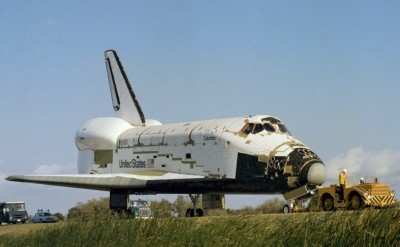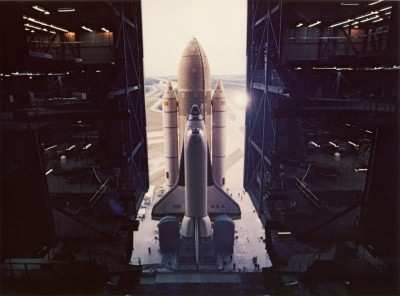What Led Up To The First Shuttle Flight
Part 1 Of A Series By Wes Oleszewski
Over the years I've encountered scores of folks who are
interested in spaceflight. Yet many of them only know the Space
Shuttle and many of those folks only have recall of the program
post-Challenger. They were either too young to pay much attention
before then, or they simply had yet to be born. For that reason I
have composed this series of stories to give them my personal
perspective on the first Space Shuttle mission as I witnessed
it.

Being a person who sat as a pre-schooler, legs crossed, on the
floor of my grandma's house and watched Alan Shepard's Freedom 7
launch and later sat, legs crossed on the hallway floor of Nelle
Haley Elementary School along with all of the other students and
watched Gemini 3 launch on TV, I later became a rabid space-buff. I
think because of that I can offer an interesting perspective. For
those of you who are of my same generation, I hope I can offer
another angle to your own memories.
A good yardstick to use in measuring public interest in the
space program is the news media. Prior to wide-spread cable TV, the
three major networks directed most of the public's attention toward
current events. After Apollo 11, people who- sadly- were born
without the aviation and aerospace gene began to lose interest in
the space program and that included the producers of national TV
news. Those of us who were farther evolved, however, simply did our
best to follow the program through any source we could find. My
parents let me stay home from school to watch the televised
critical events of Apollos 12, 13, 14,16, and 17 as well as Skylab
1, 2 and 4. My mom said I was learning more in those few hours than
I was in school anyhow. I also tried to do my best to help those
who had been born without the spaceflight gene. As a sixth grader I
spent every single one of my opportunities at classroom
"show-N-tell" holding a model of a Saturn V or an Apollo CSM or LEM
in front of my class and explaining assorted aspects of the vehicle
and program until my teacher Mrs. Rosure said "That will be enough
now Wes." I never caught on to the glazed eyes of my classmates who
had no idea as to what I was talking about. By the spring of 1970,
my classmates would groan when it was my turn at the front of the
class. They later got even with me on the dodge ball field.

Skylab was the hardest program for any space-buff to follow. In
the shadow of Watergate, most of the news media had other things to
cover and we were left with occasional radio reports by folks like
Jay Barbree. In fact, so indifferent had the news media become
about manned spaceflight that the reentry and splashdown of Skylab
4, on February 8, 1974, was the only return to earth of United
States astronauts on a US spacecraft that was not covered on
national television. I was left in my parent's living room
frantically spinning the tuner on the TV between the three major
channels and mumbling "What the…?" The media came back for
the Apollo/Soyuz Test Project (ASTP) mission in July of 1975.
Although the coverage was pretty good, we space-buffs were struck
by one single, cold fact- as far as manned spaceflight was
concerned this was pretty much "it" for the next few years.
Unlike today's situation where any plans for NASA's human
spaceflight efforts are quagmired in presidential disdain while the
agency itself dithers leaving America's space future adrift, in
1975 when ASTP splashed down there at least was the Space Shuttle
in the future. Just a year and a half after ASTP, the orbiter
test-bed Enterprise was flying at Edwards AFB on the back of the
747 carrier aircraft. At first, the media did not see this as much
of a story, but by August 12, 1977, when the first free flight of
the Approach and Landing Tests (ALT) took place- at least for the
moment the media came back, and so did many folks in America. The
coverage began early in the morning and ABC News nearly covered the
event from wheels up to wheels stop. After all, the Shuttle was new
and somewhat exciting. TV rating points may be gained. For me, ALT
blended both of my passions- aviation and space. The first ALT free
flight took place just 16 days before I arrived at Embry-Riddle in
Daytona Beach to begin my aviation career. Although much of America
once again rapidly lost interest in the ALT flights after that
first test drop, I carried my interest with me onto the
Embry-Riddle campus. Suddenly I found myself among a whole crowd of
people who were just as crazy about flying and space as I was. As
my younger brother put it, "It's like he's finally been
institutionalized."
Being that Daytona was so close to "The Cape" meant a lot of
trouble for a space-nut as it easily distract from required my
studies. So, I decided to put my space-nutdom on the back burner
and focus on becoming a professional aviator. Still, it was not
easy- in the late 70s a lot of work leading toward the shuttle was
going on. The 15,000 foot long Shuttle Runway had been constructed
and actually had an active tower. Unfortunately, the guys in the
tower had almost nothing to do. Thus, in those days, you could call
them up on the tower frequency listed on the sectional chart and
request a touch-and-go. They were always more than happy to grant
that request. So it was that as a student pilot on one of my dual
flights I landed a Cessna 172 on the Shuttle runway. Just a couple
of years later, such a thing would have been unthinkable.

On the 24th day of March, 1979 the Shuttle runway received its
first orbiter as the Columbia arrived from Palmdale, California.
Three of us drove down together and parked across the river to
watch the 747 land with the orbiter aboard. From across the river,
they looked great- like a majestic preface to the future in space.
Later, on the evening news, the story appeared quite different. Of
the 38,000 tiles in the vehicle's thermal protection system, only
60% had been installed and of those nearly a thousand had come off
on the flight to KSC. The up-close images looked far worse than
what we saw from Titusville. Two months later the Enterprise
herself came to Florida and a lot of us made the pilgrimage to the
Kennedy Space Center to take the bus tour and see her being
test-fitted on Pad 39A. Meanwhile, along the crawlerway and over by
the VAB, the number 2 and 3 Apollo launch towers as well as the
mobile service structure were being cut up. Large sections of the
launch towers had already been re-planted at pads 39 A and B to act
as shuttle Fixed Service Structures, but the portions not serving
as such were sold for scrap. The number 1 launch tower was sitting
behind the VAB, un-used. For the next year and a half the work on
the shuttle would be intense and completely behind the scenes. Even
the most rabid of space-buffs would hear very little about the
shuttle and at KSC the bus tours would see a lot of weeds growing
where fantastic things once happened. The vast majority of
Americans would focus on much more important things… like
disco, The Dukes of Hazard and the growing tally of days that the
hostages had been held in Iran. My focus was on my critical job of
stocking shelves and ringing up prescriptions in the cosmetics
department of the Daytona Kmart store in a effort to not only get
back into college, but to also somehow feed myself… where is
Sally Struthers when you need her?
It was a bitter cold Monday across Florida on the 29th of
December, 1980 as the first operational Space Shuttle stack rolled
out of the VAB. I was rolling a big metal cart of shampoo, denture
cream and glycerin suppositories out of the stockroom at the Kmart
at the same time. In the store's appliance department, the TVs
showed clips of the rollout on the local central Florida networks.
Oddly, they completely ignored my rollout of shampoo, denture cream
and glycerin suppositories. It seemed, however, that the rest of
America ignored both events alike. The stack for STS-1 (Shuttle
Transportation System- 1) resided on pad 39A for nearly two more
months until February 20, 1981 when the Flight Readiness Firing
(FRF) took place. In that test the Shuttle's main engines were
fired for 20 seconds at 100% thrust while the stack remained held
to the pad. The noise not only woke up central Florida, but it woke
up the nation- the vehicle was alive!

A month a seven days following the FRF NASA announced officially
that the launch date for the first Space Shuttle would be April
10th. Standing there in the Kmart cosmetics department I decided
that I was not going to miss it. I told Andy the pharmacist that I
was gonna be down there to see it. Andy asked what I was going to
do if I couldn't get the day off? I replied "I'll quit the job."
Knowing I only had a bicycle he asked, "How're you gonna get down
there?" I replied that if I could not get a ride, I would ride my
bike and get as far south as I could. He just shook his head and
snickered. The fact was that I had spent my whole life passionately
following spaceflight and nearly every bit of that had been sitting
in front of a TV set. There was no way I was going to be this close
to that piece of spaceflight history and again have to watch it on
TV. I was going to be THERE to witness it first hand- even if I had
to ride my bicycle.
 ANN's Daily Aero-Term (04.14.24): Maximum Authorized Altitude
ANN's Daily Aero-Term (04.14.24): Maximum Authorized Altitude ANN's Daily Aero-Linx (04.14.24)
ANN's Daily Aero-Linx (04.14.24) Classic Aero-TV: 'We're Surviving'-- Kyle Franklin Describes Airshow Life 2013
Classic Aero-TV: 'We're Surviving'-- Kyle Franklin Describes Airshow Life 2013 Aero-News: Quote of the Day (04.14.24)
Aero-News: Quote of the Day (04.14.24) Airborne 04.09.24: SnF24!, Piper-DeltaHawk!, Fisher Update, Junkers
Airborne 04.09.24: SnF24!, Piper-DeltaHawk!, Fisher Update, Junkers






